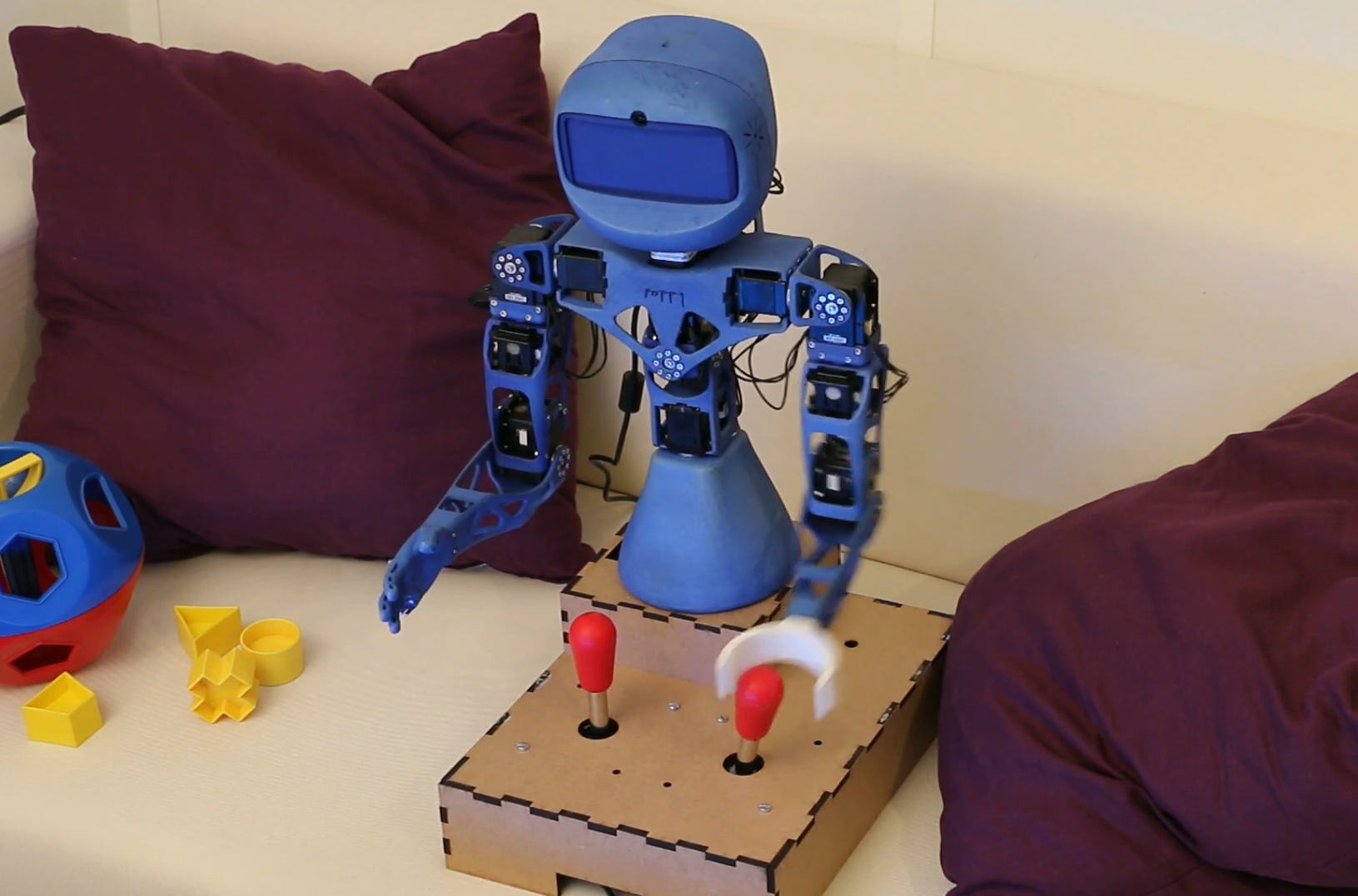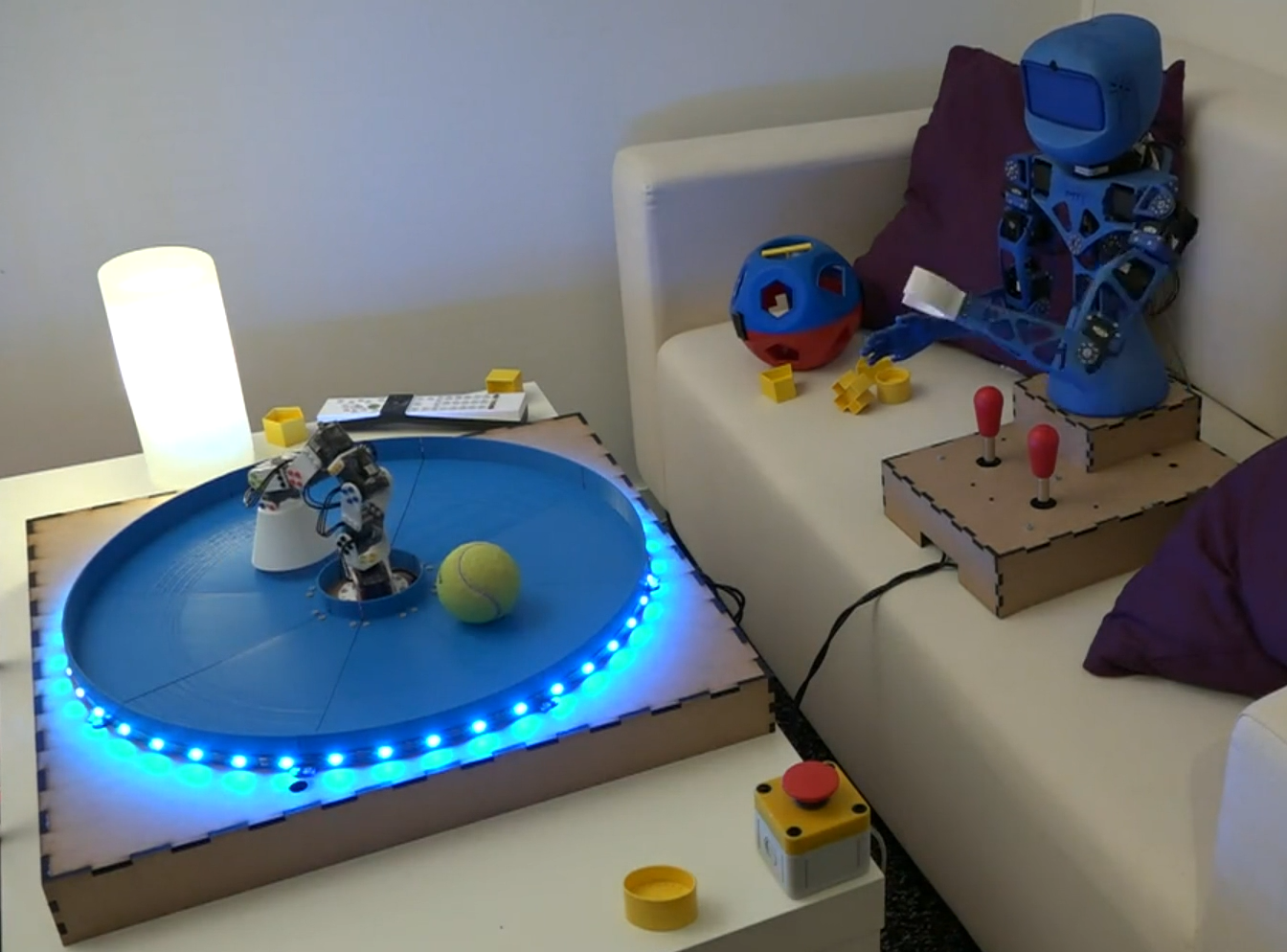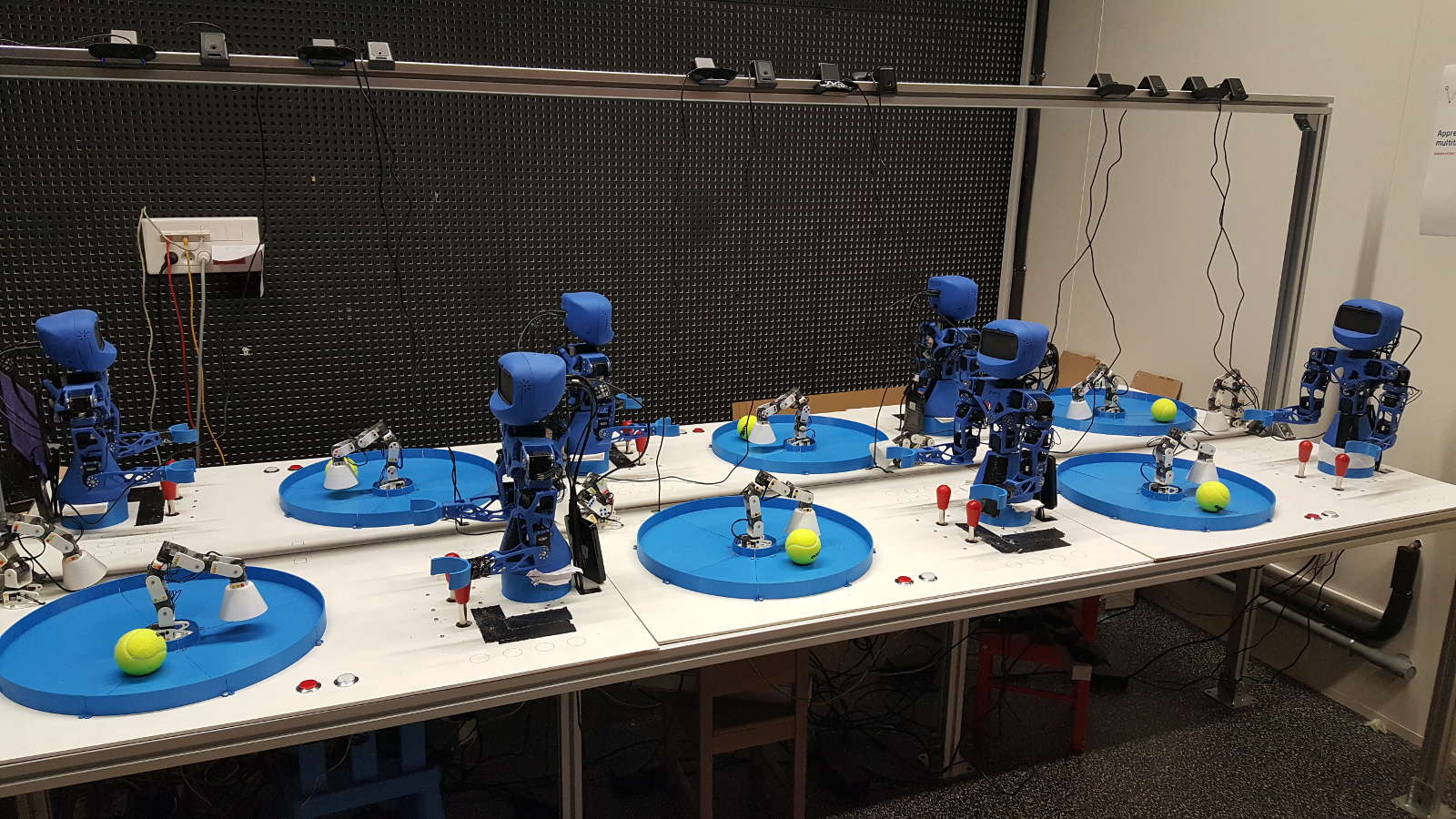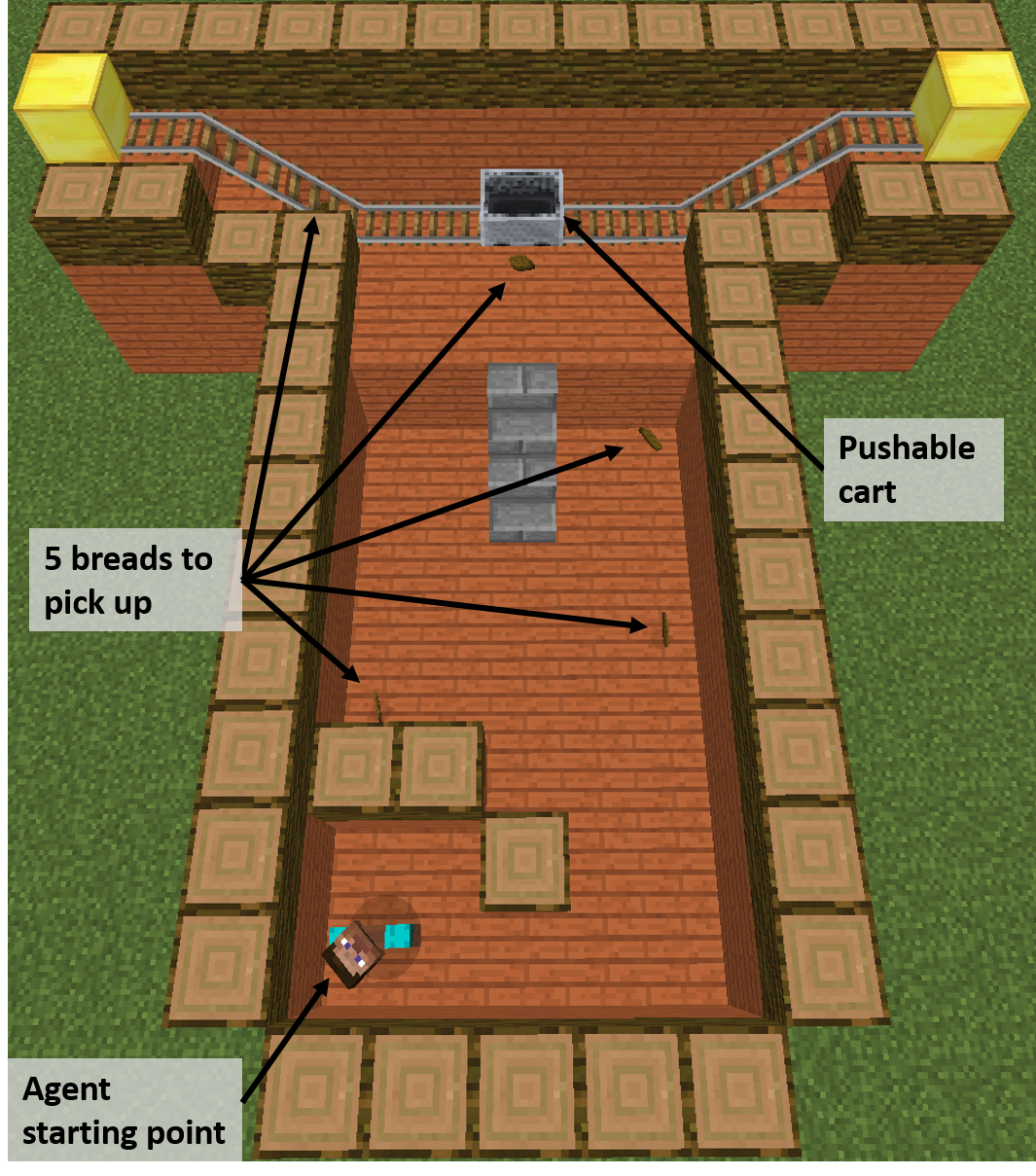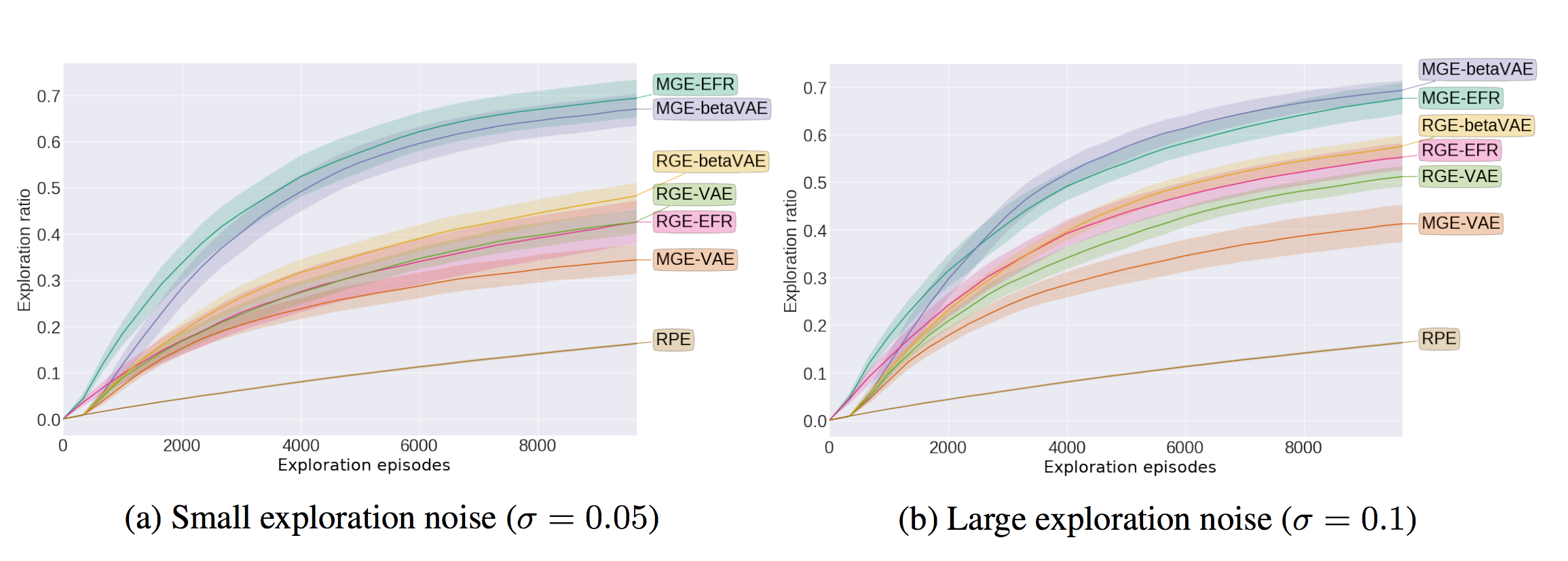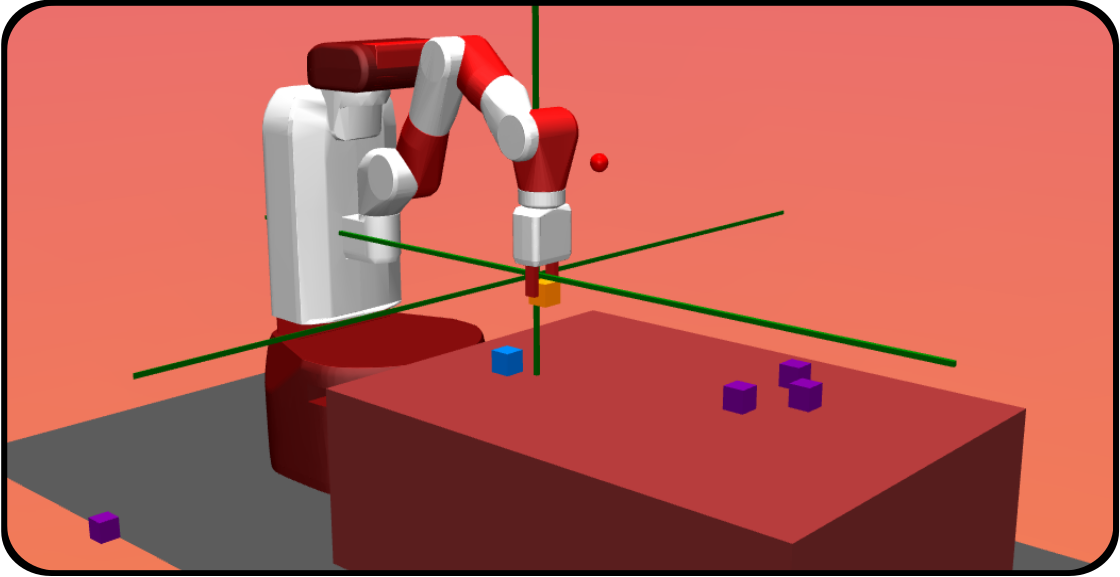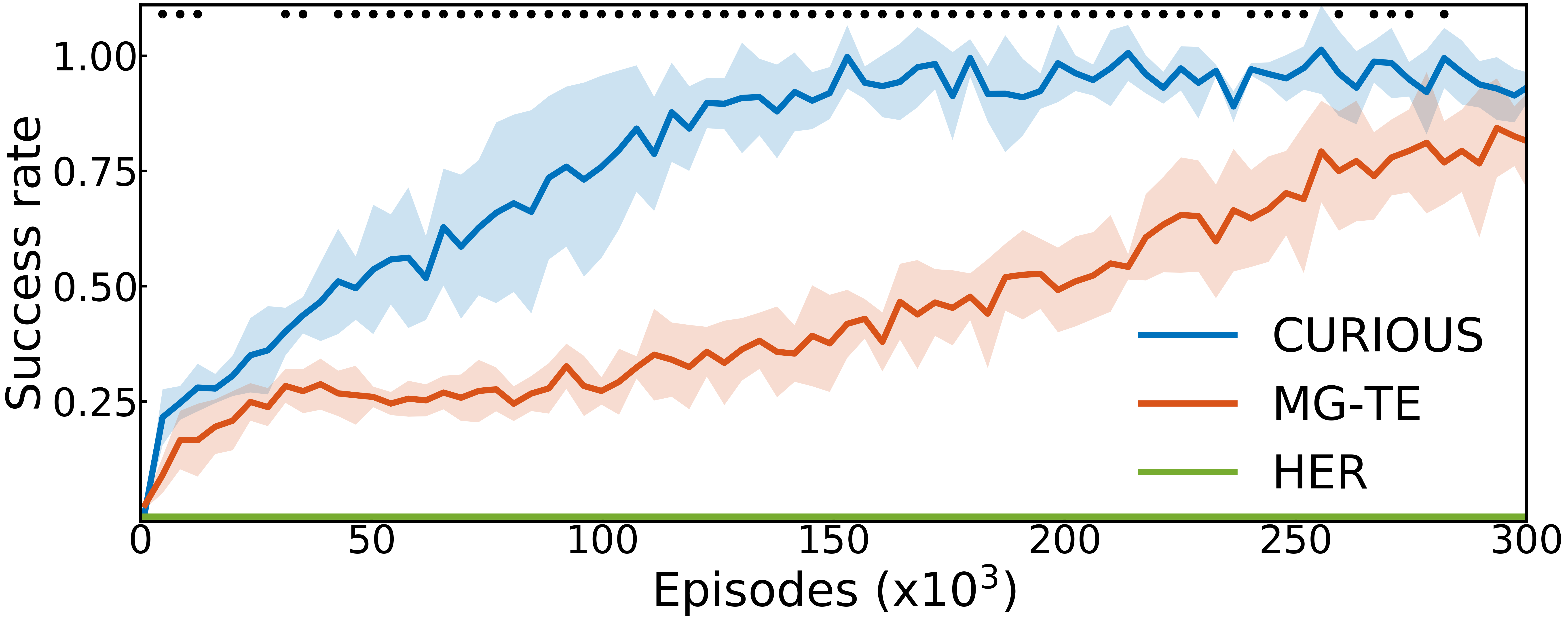Section: New Results
Autonomous Learning in Artificial Intelligence
Intrinsically Motivated Goal Exploration and Multi-Task Reinforcement Learning
Participants : Sébastien Forestier, Pierre-Yves Oudeyer [correspondant] , Alexandre Péré, Olivier Sigaud, Cédric Colas, Adrien Laversanne-Finot, Rémy Portelas.
Intrinsically Motivated Exploration of Spaces of Parameterized Goals and Application to Robot Tool Learning
A major challenge in robotics is to learn goal-parametrized policies to solve multi-task reinforcement learning problems in high-dimensional continuous action and effect spaces. Of particular interest is the acquisition of inverse models which map a space of sensorimotor goals to a space of motor programs that solve them. For example, this could be a robot learning which movements of the arm and hand can push or throw an object in each of several target locations, or which arm movements allow to produce which displacements of several objects potentially interacting with each other, e.g. in the case of tool use. Specifically, acquiring such repertoires of skills through incremental exploration of the environment has been argued to be a key target for life-long developmental learning [52].
Last year we developed a formal framework called “Unsupervised Multi-Goal Reinforcement Learning”, as well as a formalization of intrinsically motivated goal exploration processes (IMGEPs), that is both more compact and more general than our previous models [76]. We experimented several implementations of these processes in a complex robotic setup with multiple objects (see Fig. 17), associated to multiple spaces of parameterized reinforcement learning problems, and where the robot can learn how to use certain objects as tools to manipulate other objects. We analyzed how curriculum learning is automated in this unsupervised multi-goal exploration process, and compared the trajectory of exploration and learning of these spaces of problems with the one generated by other mechanisms such as hand-designed learning curriculum, or exploration targeting a single space of problems, and random motor exploration. We showed that learning several spaces of diverse problems can be more efficient for learning complex skills than only trying to directly learn these complex skills. We illustrated the computational efficiency of IMGEPs as these robotic experiments use a simple memory-based low-level policy representations and search algorithm, enabling the whole system to learn online and incrementally on a Raspberry Pi 3.
|
In order to run many systematic scientific experiments in a shorter time, we scaled up this experimental setup to a platform of 6 identical Poppy Torso robots, each of them having the same environment to interact with. Every robot can run a different task with a specific algorithm and parameters each (see Fig. 18). Moreover, each Poppy Torso can also perceives the motion of a second Poppy Ergo robot, than can be used, this time, as a distractor performing random motions to complicate the learning problem. 12 top cameras and 6 head cameras can dump video streams during experiments, in order to record video datasets. This setup is now used to perform more experiments to compare different variants of curiosity-driven learning algorithms.
|
Leveraging the Malmo Minecraft platform to study IMGEP in rich simulations
In 2018 we started to leverage the Malmo platform to study curiosity-driven learning applied to multi-goal reinforcement learning tasks (https://github.com/Microsoft/malmo). The first step was to implement an environment called Malmo Mountain Cart (MMC), designed to be well suited to study multi-goal reinforcement learning (see figure [19]). We then showed that IMGEP methods could efficiently explore the MMC environment without any extrinsic rewards. We further showed that, even in the presence of distractors in the goal space, IMGEP methods still managed to discover complex behaviors such as reaching and swinging the cart, especially Active Model Babbling which ignored distractors by monitoring learning progress.
|
Unsupervised Deep Learning of Goal Spaces for Intrinsically Motivated Goal Exploration
Intrinsically motivated goal exploration algorithms enable machines to discover repertoires of policies that produce a diversity of effects in complex environments. These exploration algorithms have been shown to allow real world robots to acquire skills such as tool use in high-dimensional continuous state and action spaces. However, they have so far assumed that self-generated goals are sampled in a specifically engineered feature space, limiting their autonomy. We have proposed an approach using deep representation learning algorithms to learn an adequate goal space. This is a developmental 2-stage approach: first, in a perceptual learning stage, deep learning algorithms use passive raw sensor observations of world changes to learn a corresponding latent space; then goal exploration happens in a second stage by sampling goals in this latent space. We made experiments with a simulated robot arm interacting with an object, and we show that exploration algorithms using such learned representations can closely match, and even sometimes improve, the performance obtained using engineered representations. This work was presented at ICLR 2018 [38].
Curiosity Driven Exploration of Learned Disentangled Goal Spaces
As described in the previous paragraph, we have shown in [38] that one can use deep representation learning algorithms to learn an adequate goal space in simple environments. However, in the case of more complex environments containing multiple objects or distractors, an efficient exploration requires that the structure of the goal space reflects the one of the environment. We studied how the structure of the learned goal space using a representation learning algorithm impacts the exploration phase. In particular, we studied how disentangled representations compare to their entangled counterparts [28].
Those ideas were evaluated on a simple benchmark where a seven joints robotic arm evolves in an environment containing two balls. One of the ball can be grasped by the arm and moved around whereas the second one acts as a distractor: it cannot be grasped by the robotic arm and moves randomly across the environment.
|
Our results showed that using a disentangled goal space leads to better exploration performances than an entangled goal space: the goal exploration algorithm discovers a wider variety of outcomes in less exploration steps (see Figure 20). We further showed that when the representation is disentangled, one can leverage it by sampling goals that maximize learning progress in a modular manner. Lastly, we have shown that the measure of learning progress, used to drive curiosity-driven exploration, can be used simultaneously to discover abstract independently controllable features of the environment.
Combining deep reinforcement learning and curiosity-driven exploration
A major challenge of autonomous robot learning is to design efficient algorithms to learn sensorimotor skills in complex and high-dimensional continuous spaces. Deep reinforcement learning (RL) algorithms are natural candidates in this context, because they can be adapted to the problem of learning continuous control policies with low sample complexity. However, these algorithms, such as DDPG [97] suffer from exploration issues in the context of sparse or deceptive reward signals.
In this project, we investigate how to integrate deep reinforcement learning algorithms with curiosity-driven exploration methods. A key idea consists in decorrelating the exploration stage from the policy learning stage by using a memory structure used in deep RL called a replay buffer. Curiosity-driven exploration algorithms, also called Goal Exploration Processes (GEPs) are used in a first stage to efficiently explore the state and action space of the problem, and the corresponding data is stored into a replay buffer. Then a DDPG learns a control policy from the content of this replay buffer.
Last year, an internship has been dedicated to trying this methodology in practice but did not reach conclusions because of instability issues related to DDPG. The project was restarted this year, which led to an ICML publication [25]. We used an open-source implementations [72], and compared the combination GEP-PG (GEP + DDPG) to the traditional DDPG [97] as well as the former state-of-the art DDPG implementation endowed with parameter-based exploration [131]. Results were presented on the popular OpenAI Gym benchmarks Continuous Mountain Car (CMC) and Half-Cheetah (HC) [58], where state-of-the-art results were demonstrated.
|
Monolithic Intrinsically Motivated Multi-Goal and Multi-Task Reinforcement Learning
In this project we merged two families of algorithms. The first family is the Intrinsically Motivated Goal Exploration Processes (IMGEP) developped in the team (see [77] for a description of the framework). In this family, autonomous learning agents sets their own goals and learn to reach them. Intrinsic motivation under the form of absolute learning progress is used to guide the selection of goals to target. In some variations of this framework, goals can be represented as coming from different modules or tasks. Intrinsic motivations are then used to guide the choice of the next task to target.
The second family encompasses goal-parameterized reinforcement learning algorithms. The first algorithm of this category used an architecture called Universal Value Function Approximators (UVFA), and enabled to train a single policy on an infinite number of goals (continuous goal spaces) [137] by appending the current goal to the input of the neural network used to approximate the value function and the policy. Using a single network allows to share weights among the different goals, which results in faster learning (shared representations). Later, HER [49] introduced a goal replay policy: the actual goal aimed at, could be replaced by a fictive goal when learning. This could be thought of as if the agent were pretending it wanted to reach a goal that it actually reached later on in the trajectory, in place of the true goal. This enables cross-goal learning and speeds up training. Finally, UNICORN [105] proposed to use UVFA to achieve multi-task learning with a discrete task-set.
In this project, we developed CURIOUS [43], an intrinsically motivated reinforcement learning algorithm able to achieve both multiple tasks and multiple goals with a single neural policy. It was tested on a custom multi-task, multi-goal environment adapted from the OpenAI Gym Fetch environments [58], see Figure 22. CURIOUS is inspired from the second family as it proposes an extension of the UVFA architecture. Here, the current task is encoded by a one-hot code corresponding to the task id. The goal is of size
|
CURIOUS is also inspired from the first family, as it self-generates its own tasks and goals and uses a measure of learning progress to decide which task to target at any given moment. The learning progress is computed as the absolute value of the difference of non-overlapping window average of the successes or failures
where
In this project, we compare CURIOUS to two baselines: 1) a flat representation algorithm where goals are set from a multi dimensional space including all tasks (equivalent to HER); 2) a task-expert algorithm where a multi-goal UVFA expert policy is trained for each task. The results are shown in Figure 24.
Transfer Learning from Simulated to Real World Robotic Setups with Neural-Augmented Simulators
Participants : Florian Golemo [correspondant] , Pierre-Yves Oudeyer.
This work was made in collaboration with Adrien Ali Taiga and Aaron Courville, and presented at CoRL 2018 [27]. Reinforcement learning with function approximation has demonstrated remarkable performance in recent years. Prominent examples include playing Atari games from raw pixels, learning complex policies for continuous control, or surpassing human performance on the game of Go. However most of these successes were achieved in non-physical environments (simulations, video games, etc.). Learning complex policies on physical systems remains an open challenge. Typical reinforcement learning methods require a lot of data which makes it unsuitable to learn a policy on a physical system like a robot, especially for dynamic tasks like throwing or catching a ball. One approach to this problem is to use simulation to learn control policies before applying them in the real world. This raises new problems as the discrepancies between simulation and real world environments ("reality gap") prevent policies trained in simulation from performing well when transfered to the real world. This is an instance of domain adaption where the input distribution of a model changes between training (in simulation) and testing (in real environment). The focus of this work is in settings where resetting the environment frequently in order to learn a policy directly in the real environment is highly impractical. In these settings the policy has to be learned entirely in simulation but is evaluated in the real environment, as zero-shot transfer.
In simulation there are differences in physical properties (like torques, link weights, noise, or friction) and in control of the agent, specifically joint control in robots. We propose to compensate for both of these source of issues with a generative model to bridge the gap between the source and target domain. By using data collected in the target domain through task-independent exploration we train our model to map state transitions from the source domain to state transition in the target domain. This allows us to improve the quality of our simulated robot by grounding its trajectories in realistic ones. With this learned transformation of simulated trajectories we are able to run an arbitrary RL algorithm on this augmented simulator and transfer the learned policy directly to the target task. We evaluated our approach in several OpenAI gym environments that were modified to allow for drastic torque and link length differences.
Curiosity-driven Learning for Automated Discovery of Physico-Chemical Structures
Participants : Chris Reinke [correspondant] , Pierre-Yves Oudeyer.
Intrinsically motivated goal exploration algorithms enable machines to discover repertoires of action policies that produce a diversity of effects in complex environments. In robotics, these exploration algorithms have been shown to allow real world robots to acquire skills such as tool use in high-dimensional continuous state and action spaces (e.g. [75], [53]). In other domains such as chemistry and physics, they open the possibility to automate the discovery of novel chemical or physical structures produced by complex dynamical systems (e.g. [132]). However, they have so far assumed that self-generated goals are sampled in a specifically engineered feature space, limiting their autonomy. Recent work has shown how unsupervised deep learning approaches could be used to learn goal space representations (e.g. [38]), but they have focused on goals represented as static target configurations of the environment in robotics sensorimotor spaces. This project studies how these new families of machine learning algorithms can be extended and used for automated discovery of behaviours of dynamical systems in physics/chemistry.
The work on the project started in November 2018 and is currently in the state of exploring potential systems and algorithms.
Statistical Comparison of RL Algorithms.
In this project [42], we review the statistical tests recommended by [87] to compare RL algorithms (T-test, bootstrap test, Kolmogorov-Smirnov). Kolmogorov-test is discarded as it only allows to compare distributions and not mean or median performance. We wrote a tutorial in the form of an arxiv paper [42] to present the use of the Welch's t-test and the bootstrap test to compare algorithm performances. In the last section of that paper, initial assumptions of the test are described. In particular, two limiting points are discussed. First, the computation of the required sample size to satisfy requirements in type-II error (false negative) is highly sensitive to the estimations of the empirical standard deviations of the algorithms performance distributions. It is showed that for small sample sizes (< 20) the empirical standard deviation of a Gaussian distribution is biased negatively in average. Using an empirical standard deviation smaller than the true one results in under-estimations of the type-II error and therefore of the required sample size to meet requirement on that error. Second we propose empirical estimations of the type-I error (false positive) as a function of the sample size for the Welch's t-test and the bootstrap test for a particular example (Half-Cheetah environment from OpenAI Gym [58] using DDPG algorithm [97]). It is showed that the type-I error is largely underestimated by the bootstrap test for small sample size (x6 for



